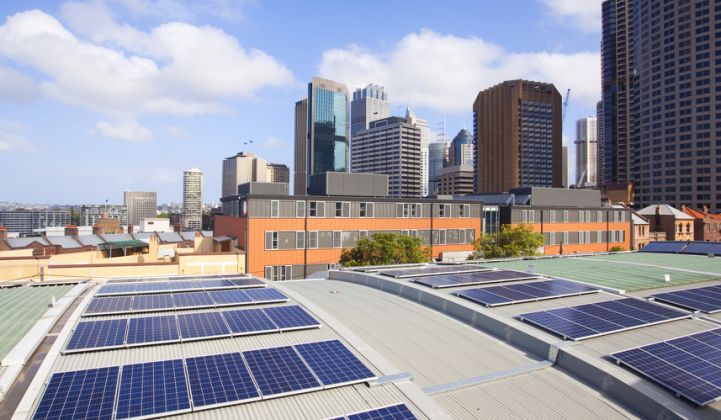Sungevity, the No. 3 U.S. provider of residential solar installations, is moving into the commercial market. It's a new channel for the firm as it joins forces and partners with commercial-scale solar financier Sol Systems. Sungevity will focus on what it calls the "underserved small business sector," with systems sized between 20 kilowatts and 300 kilowatts. Sungevity already has a "footprint in 12 U.S. states, Washington, D.C., the Netherlands and Australia," according to a release.
The commercial solar market lost some ground in 2014, with installations down 6 percent year-over-year. Still, system prices have continued to fall, despite the lack of rooftop installs. According to GTM Research, the cost for a medium-scale commercial system averaged $2.25 per watt by the end of 2014. This is down from $2.53 per watt in the first quarter of 2014.
Sungevity's partner, Sol Systems, has helped finance 180 megawatts of commercial, distributed generation solar projects. (Here's a video reporting on Sol System's work of late.)
Steve Birndorf, director of commercial solar at Sungevity, said that when people think about commercial solar, "they think large-scale, investment-grade -- municipalities, school districts and big-box stores," adding, "We think this is a major shift." Birndorf said Sungevity won't be installing on rooftops of stores like Ikea or Macy's: "We believe the more interesting and ripe business is in the small commercial space."
Birndorf continued: "As a salesperson, I see the ITC [reduction] as two years away. There is so much opportunity today and a lot to do in the next two years." In contrast to today's 12- to 18-month sales cycles, Birndorf envisions a time when the implementation of standardized processes decreases the period between the sale to permission to operate to 2 to 3 weeks.
FIGURE: Leading U.S. Residential Solar Installers, 2014
Source: GTM Research U.S. PV Leaderboard, Q1 2015
Andrew Birch, the CEO and co-founder of Sungevity, suggested that Sungevity's customers are already providing low-cost commercial referral leads to the company's sales network.
As far as the loss of the ITC is concerned, the CEO said, "We control our own cost and destiny -- we are growing internationally in the EU and Australia." He concluded, "The real innovation is the customer experience."
According to its recent earnings call, as reported in Recharge, "Vivint will enter into a tax-equity partnership 'in the near future' to finance its C&I ambitions. The residential market will remain the company’s primary line of business, with Vivint turning to partners to handle the engineering, permitting, construction and O&M work associated with its C&I projects, at least initially. Vivint does not expect its C&I installations to account for more than 10 percent of its business by the end of 2016, and any C&I installations it completes in 2015 would come on top of its 290- to 310-megawatt guidance."
Greenskies Renewable Energy just signed an enormous agreement to install solar arrays on the roofs of 180 Target stores and distribution centers, for a total of approximately 100 megawatts. The average system is expected to boast about 1,700 solar panels. Greenskies will design, develop, finance, own and maintain each of the solar installations, while Target has agreed to purchase all of the electricity produced at each of the sites. Greenskies has more than 90 megawatts of solar installations in operation, plus an additional 1,300 megawatts of solar projects in various stages of development throughout the United States. All 180 projects across the U.S. are expected to be completed by the winter of 2016.
According to the Wall Street Journal, residential solar installer Sunrun is going public later this year. We suggested this might happen in a recent IPO candidate forecast.
Sunrun has collected $300 million, valuing the firm at $1.3 billion, from venture firms including Accel Partners, Foundation Capital, Madrone Capital Partners and Sequoia Capital. The timing and pricing of the IPO have not been revealed. A new CFO, Bob Komin, was added this week.
Sunrun has more customers than Vivint, but far fewer than SolarCity. The company deployed about 100 megawatts of residential solar in 2013.
Lynn Jurich, CEO and co-founder of Sunrun, told GTM last year, “I think a lot of people look at an IPO as the endgame. It’s not. It’s just a financing.”
In February 2013, Sunrun acquired REC Solar's residential division (solar sales and installation), AEE Solar (distribution) and SnapNrack (mounting systems). That made Sunrun a vertically integrated solar installer with trucks, as well as a financier with a direct sales force like those of SolarCity and Vivint. The REC acquisition gave Sunrun a large, established, multi-state direct-installer channel.



